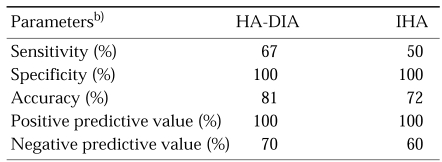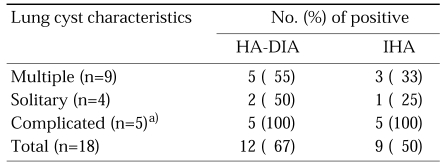Abstract
The diagnosis of human hydatidosis is primarily made using radiological and serological methods. Radiological methods are generally of low specificity and serological methods lack sensitivity, especially for pulmonary disease. In this study the capabilities of a new rapid test, the hydatid antigen dot immunobinding assay (HA-DIA), which was developed for the diagnosis of pulmonary hydatidosis, were studied and compared with another immunodiagnostic method, indirect hemagglutination (IHA). The study subjects included 18 patients, 9 women, 9 men; range 7 to 63 years; mean 30 years, with surgically proven pulmonary hydatidosis, a control group comprised of 14 patients; viral respiratory infections (1), cirrhosis (2), connective tissue disease (2), taeniasis (3), and 6 healthy donors. We found that the HA-DIA test had a sensitivity of 67% and specificity of 100%, and that the IHA test had a sensitivity of 50% and specificity of 100%. We conclude that HA-DIA is a simple, rapid, low cost assay that does not require instrumentation and has a higher sensitivity than IHA for the diagnosis of pulmonary hydatidosis.
Keywords: Echinococcus granulosus, pulmonary hydatidosis, hydatid antigen, dot immunobinding assay
INTRODUCTION
Hydatid cyst disease (hydatidosis), one of the oldest diseases known to mankind, is caused by two Echinococcus spp. cestodes, namely, E. granulosus and E. vogeli, and is a worldwide public health problem, especially in livestock-raising areas in developing countries. In Turkey the incidence of the disease has been estimated to be 2 cases per 100,000 of the population per year. The hydatid cysts of E. granulosus tend to form in the liver (50 to 70% of patients), or in the lungs (20-30%), but may be found in any organ of the body, such as the brain, heart, spleen, kidney and bones (King, 2000). Laboratory diagnosis of pulmonary hydatidosis is important because lung involvement may be confused with many other disease entities such as lung tumors, for which radical resection is the most effective therapy. Imaging remains more sensitive than serodiagnosis but, because of low specificity, suspected lesions on imaging studies must be confirmed serologically.
Various immunological tests have been developed for the diagnosis of hydatidosis, such as, an intradermal test (Casoni), complement fixation, direct and indirect hemagglutination, latex agglutination, indirect fluorescent antibody, immunoelectrophoresis, ELISA, and a radioallergen absorbency test (RAST). The results obtained from these tests differ from according to the characteristics and locations of cysts, though in general ELISA seems to be more sensitive than the other methods (Force et al, 1992). Cases of pulmonary hydatidosis show a reduced sensitivity to immunodiagnostic tests, as compared to liver hydatidosis, probably due to reduced antigenemia in the former (Force et al., 1992; King, 2000). With the exception of the intradermal test, which is considered unreliable because of its poor specificity, all of the above tests are time-consuming and require access to a laboratory with proper instrumentation and trained technicians.
The hydatid antigen dot immunobinding assay (HA-DIA) was developed to meet these needs. It's a rapid, simple test that does not require laboratory facilities, and can be used in a doctor's office, for field epidemiological surveys in developing countries, or for diagnostic confirmation. HA-DIA allows detection of the Echinococcus specific antibodies and is a form of dot immunobinding assay (DIA). The aim of this study was to determine the sensitivity and specificity of the HA-DIA assay and to compare its validity versus indirect hemagglutination (IHA) testing for the diagnosis of pulmonary hydatidosis.
MATERIALS AND METHODS
Subjected patients
We studied 18 patients with surgically proven pulmonary hydatidosis, (9 women and 9 men, range 7-63 years, mean 30 years), and control group of 14 patients; with viral respiratory infection (1), cirrhosis (2), connective tissue disease (2), taeniasis (3), and 6 healthy donors, using the two diagnostic methods, namely IHA and HA-DIA. Eleven patients confirmed to have the pulmonary hydatidosis by operation were tested pre-operatively, and 7 patients with the disease were tested 1 week to 4 months (mean 2 months) post-operatively.
Methods
For IHA testing, we used a commercially available kit that detects anti-Echinococcus granulosus antibodies present in serum using an indirect hemagglutination reaction according to the directions of the manufacturer (Cellognost-Echinococcus-IHA, Behring, Germany). Antibody titers greater than 1:320 were considered to be positive. HA-DIA is a new technology developed for the diagnosis of human hydatidosis that allows the detection of Echinococcus granulosus specific antibodies in blood samples (Echinostrip, Lofarma Laboratories, Milan). The test measures serum antigen binding, which is positively related to the concentration of the antibody specific for hydatid antigen. The antigen used in this test is obtained from hydatid fluid collected from fertile cysts in bovine livers and lungs, and bound to nitrocellulose reactive areas on plastic stick supports. The second reagent consists in the same antigen and is adsorbed on a colloidal dye suspension (pink). Its colloidal state allows its manufacturing in aqueous suspensions and it has a strong chemical affinity for the cellulose fibers. The hydatid antigen is bound to such colloidal dye, which is stabilized with a layer of inert protein. In these conditions the chemical affinity of the colloidal dye for the fibers is blocked and the incubation of the two reagents (sticks and colloidal dye) in the absence of serum or in the presence of antibody negative serum is unable to provoke the dying cellulose area which remains white. In the presence of serum which contains Hydatid-specific antibodies, the antigen antibody reaction causes disturbance in the stabilizing protein layer on the colloidal dye particles, which then become able to color the spot on the stick. Test procedure is briefly as follows: In a tube, the 200 µl serum sample is incubated simultaneously with the 600 µl of the colloidal dye and with the sticks for 30-90 minutes and after the incubation period the sticks were washed under tap water. In the presence of antigen specific antibodies, the colloidal dye reacts with the stick reactive area and a pink colored reaction occurs. Color intensity increases according to the antibody titer of the serum. In the absence of the specific antibody no color reaction occurs. Test positivity was arbitrarily graded from 1 + to 3 +, depending on spot intensity.
RESULTS
HA-DIA test detected 6 of 11 (sensitivity 54.5%) pre-operative and 6 of 7 (sensitivity 85.7%) post-operative patients with pulmonary hydatidosis, whereas the IHA test detected 5 of 11 (sensitivity 45.4%) and 4 of 7 (sensitivity 57.1%), respectively. Overall sensitivity was 67% for the HA-DIA test and 50% for IHA test. A comparison of IHA and HA-DIA test results are summarized in Table 1.
Table 1.
Comparison of the diagnostic abilities of hydatid antigen dot immunobinding assay (HA-DIA) and indirect hemagglutination assay (IHA) for pulmonary hydatidosisa)
a)All cases of pulmonary hydatidosis were proven by post-surgical pathological investigations.
b)None of the parameter differences between the two tests has reached a statistical significance (chi-square, P = 0.157).
Both tests were negative for all control group subjects. The characteristics of cysts (ie., multiple, solitary, complicated by suppuration or perforation) and the test results are summarized in Table 2. Both tests showed 100% sensitivity for complicated cysts. Test sensitivities were clearly lower for non-complicated cysts (Table 2).
Table 2.
Correlation between characteristics of lung cysts and serological results
a)Complicated cysts are suppurative or perforated cysts.
DISCUSSION
In a large study by Force et al. (1992), which evaluated eight serological tests for the diagnosis of human hydatidosis, the most sensitive serological test was found to be IgG ELISA (as has been found by many other studies) with a sensitivity of 94% for liver diseases and 62% for lung diseases. In that study, the sensitivity of IHA for pulmonary hydatidosis was found to be 56%, which is similar to our finding of 50%. In our study, the sensitivity of HA-DIA was 67%, which appeared a little more sensitive than the IgG ELISA results of Force et al. (1992), but less sensitive than that of Babba et al. (1994).
Also in our study, both tests showed 100% sensitivity for complicated cysts (5/5). It is highly likely that development of a complicated cyst, such as a perforation, results in releasing of high amounts of antigens into the circulation so that they are more readily detected by the serological assays.
Another interesting finding was that, positive rates of IHA and HA-DIA tests were higher in post-operative cases than in pre-operative cases, although this difference was not statistically significant (p > 0.05). This might also have been due to an increased release of antigens to the circulation as a result of surgical manipulation.
The sensitivity of the HA-DIA test for the diagnosis of pulmonary hydatidosis was lower in our study (67%) than that for liver hydatidosis (100%). This finding is same as previous results by ELISA or other immunodiagnostic methods (Force et al., 1992; Misterello et al., 1995; King, 2000).
Our study demonstrates that the sensitivity of HA-DIA is comparable to that of other serological tests such as ELISA and IHA, for the diagnosis of pulmonary hydatidosis. However, its sensitivity is too low to enable it to be used as a single test. As previously stated in many studies, it is better to combine two or more tests and imaging methods to achieve the desired levels of diagnostic accuracy in human hydatidosis, especially for pulmonary hydatid disease (Force et al., 1992; Babba et al., 1994., Devi and Parija 2003).
References
- 1.Babba H, Messedi A, Masmoudi S. Diagnosis of human hydatidosis: Comparison between imagery and six serologic techniques. Am J Trop Med Hyg. 1994;50:64–68. doi: 10.4269/ajtmh.1994.50.64. [DOI] [PubMed] [Google Scholar]
- 2.Devi CS, Parija SC. A new serum hydatid antigen detection test for diagnosis of cystic echinococcosis. Am J Trop Med Hyg. 2003;69:525–528. [PubMed] [Google Scholar]
- 3.Force L, Torres JM, Carillo A, Busca J. Evaluation of eight serological tests in the diagnosis of human echinococcosis and follow-up. Clin Infect Dis. 1992;15:473–480. doi: 10.1093/clind/15.3.473. [DOI] [PubMed] [Google Scholar]
- 4.King CH. Echinococcosis. In: Mandell GL, Bennet JE, Dolin R, editors. Principles and Practice of Infectious Diseases. 5th ed. New York, USA: Churchill Livingstone; 2000. pp. 2962–2963. [Google Scholar]
- 5.Misterello G, Gentili M, Falagini P, Roncarolo D, Riva G, Tinelli M. Dot immunobinding assay as a new diagnostic test for human hydatid disease. Immunol Lett. 1995;47:79–85. doi: 10.1016/0165-2478(95)00068-g. [DOI] [PubMed] [Google Scholar]




